c. Late Third Century–335; Patron Saint of animals, harvests, and stonemasons; Pre-Congregation canonization
Little is known about the early life of Pope Saint Sylvester I, but many legends have emerged over the centuries. He is believed to have been born in Rome to Christian parents and raised as a devout follower of Christ. He was ordained a priest in Rome where he served during one of the severe persecutions of the Church.
In 303, Emperor Diocletian and his co-emperor Galerius issued a series of edicts outlawing Christianity. By that time, the Church had substantially expanded within the empire, although it was still a minority religion. The new edicts led to the destruction of churches, the burning of sacred texts, and legal punishments against Christians. When Christians were reported to the authorities, they were required to offer sacrifice to the Roman gods and renounce their faith. Those who refused were often imprisoned, tortured, and even killed.
In 312, the co-emperors of the West, Constantine and Maxentius, were at war, each making their own claim as ruler following Diocletian’s death the year before. Just prior to their final battle at the Milvian Bridge, Constantine, who was sympathetic toward Christianity, saw a sign in the sky that would change Christianity and the Roman Empire forever. Church historian Eusebius tells the famous story this way:
About the time of the midday sun, when day was just turning, he [Constantine] said he saw with his own eyes, up in the sky and resting over the sun, a cross-shaped trophy formed from light, and a text attached to it which said, ‘By this conquer’…He was, he said, wondering to himself what the manifestation might mean; then, while he meditated, and thought long and hard, night overtook him. Thereupon, as he slept, the Christ of God appeared to him with the sign which had appeared in the sky, and urged him to make himself a copy of the sign which had appeared in the sky, and to use this a protection against the attacks of the enemy.
The sign was the cross. Constantine and his troops painted the cross on their shields, and his army was victorious. The following year, Constantine and Eastern Emperor Licinius issued the Edict of Milan that legalized Christianity. Constantine immediately began to work closely with Pope Miltiades. However, Pope Miltiades died in January of 314 and, within that same month, Sylvester was elected, making him the first pontiff whose entire papacy took place under the support and protection of the Roman emperor.
It is difficult to speak about Pope Sylvester’s papacy without intertwining it with Emperor Constantine the Great. Constantine had already given Pope Miltiades the palace of Empress Fausta in Rome for his residence, known as the Lateran Palace. Once Sylvester became pope, he took possession of the palace and expanded it with the support of Constantine. It was dedicated in 324, making it the official cathedral church and residence of the pope. Today it is named the Basilica of Saint John Lateran. With the support of Constantine, several other churches and chapels were built in Rome and the Holy Land, such as the Basilica of the Holy Cross in Jerusalem, Old St. Peter’s Basilica in Rome, and chapels built over the graves of martyrs. Constantine also furnished the churches well, while Pope Sylvester oversaw their construction and beautification.
Around the year 318, Arius, a priest in Alexandria, accused his bishop of heresy and preached that the Son of God was subordinate to the Father, lacking eternal divinity. After a local synod exiled Arius, he began to travel the empire, preaching his heresy and winning followers. Pope Sylvester and Emperor Constantine soon became aware of the controversy. In 325, with the pope’s blessing and support, the emperor called the first ecumenical council in Nicaea. Though Pope Sylvester did not personally attend, he sent papal delegates who presented his position and consented to the outcome of the council. The council addressed Arius’ heresy, which denied Christ’s divinity. A deacon from Alexandria named Athanasius strongly defended Christ’s divinity. The council of over 300 bishops formulated the Nicene Creed to affirm the Church’s faith. Only two bishops, along with Arius, refused to accept it and were exiled. Deacon Athanasius was soon after chosen as Bishop of Alexandria and is known today as Saint Athanasius.
Since Pope Sylvester was the first pope to serve the Church under the legal support of the emperor, and because he did so for twenty-one years, he is often seen as the first formal administrator of the Church. He had a palace, money, numerous converts, and the organizational support of the emperor. The centuries of persecution built the foundation of the Church, and Pope Sylvester began to build the actual structure of the Church.
One of the lasting effects of the relationship between Pope Sylvester and Emperor Constantine came from a forged eighth-century document called “The Donation of Constantine.” That document relates a story that Constantine was cured of leprosy by Pope Sylvester and, in gratitude, Constantine bestowed the pope with temporal power over Rome and the western part of the Roman Empire. Upon doing so, Constantine moved to Constantinople and ruled the Eastern part of the Empire. By the Middle Ages, this forged document greatly influenced the political and religious landscape of medieval Europe. Later popes and rulers used it to support the position that the pope was not only a spiritual ruler but also a temporal ruler in Rome and in much of Italy, and that all temporal rulers were subservient to the pope.
As we honor Pope Sylvester today, ponder the fact that in many ways, the Church we have today began with him. Though the faith was purified and articulated in the first centuries, the great basilicas, ecumenical councils, and organized administration of the Church began with Pope Sylvester. Pray for the Church today as we honor this important pope. The Church always has and always will be flawed in her members and leaders, but the fact that the Church has survived for more than 2,000 years is a testimony to its divine institution and a guarantee from Christ that the gates of hell will not prevail against it when Peter, in the person of the pope, remains in charge.
Source: https://mycatholic.life/saints/saints-of-the-liturgical-year/31-december-saint-sylvester-i-pope–optional-memorial/








